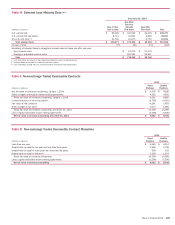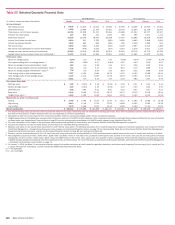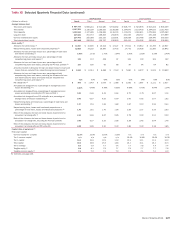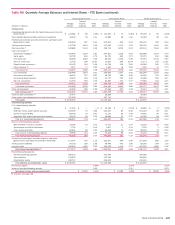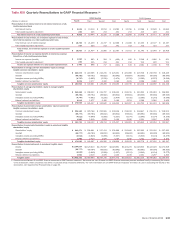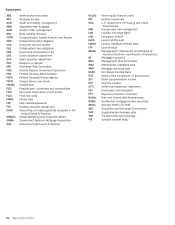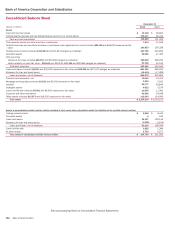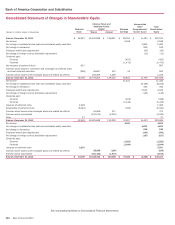Bank of America 2014 Annual Report Download - page 137
Download and view the complete annual report
Please find page 137 of the 2014 Bank of America annual report below. You can navigate through the pages in the report by either clicking on the pages listed below, or by using the keyword search tool below to find specific information within the annual report.Bank of America 2014 135
Matched Book – Repurchase and resale agreements and securities
borrowed and loaned transactions entered into to accommodate
customers and earn interest rate spreads.
Mortgage Servicing Right (MSR) – The right to service a mortgage
loan when the underlying loan is sold or securitized. Servicing
includes collections for principal, interest and escrow payments
from borrowers and accounting for and remitting principal and
interest payments to investors.
Net Interest Yield – Net interest income divided by average total
interest-earning assets.
Nonperforming Loans and Leases – Includes loans and leases that
have been placed on nonaccrual status, including nonaccruing
loans whose contractual terms have been restructured in a manner
that grants a concession to a borrower experiencing financial
difficulties (TDRs). Loans accounted for under the fair value option,
PCI loans and LHFS are not reported as nonperforming loans and
leases. Consumer credit card loans, business card loans,
consumer loans secured by personal property (except for certain
secured consumer loans, including those that have been modified
in a TDR), and consumer loans secured by real estate that are
insured by the FHA or through long-term credit protection
agreements with FNMA and FHLMC (fully-insured loan portfolio)
are not placed on nonaccrual status and are, therefore, not
reported as nonperforming loans and leases.
Purchased Credit-impaired (PCI) Loan – A loan purchased as an
individual loan, in a portfolio of loans or in a business combination
with evidence of deterioration in credit quality since origination for
which it is probable, upon acquisition, that the investor will be
unable to collect all contractually required payments. These loans
are recorded at fair value upon acquisition.
Subprime Loans – Although a standard industry definition for
subprime loans (including subprime mortgage loans) does not
exist, the Corporation defines subprime loans as specific product
offerings for higher risk borrowers, including individuals with one
or a combination of high credit risk factors, such as low FICO
scores, high debt to income ratios and inferior payment history.
Troubled Debt Restructurings (TDRs) – Loans whose contractual
terms have been restructured in a manner that grants a concession
to a borrower experiencing financial difficulties. Certain consumer
loans for which a binding offer to restructure has been extended
are also classified as TDRs. Concessions could include a reduction
in the interest rate to a rate that is below market on the loan,
payment extensions, forgiveness of principal, forbearance, loans
discharged in bankruptcy or other actions intended to maximize
collection. Secured consumer loans that have been discharged in
Chapter 7 bankruptcy and have not been reaffirmed by the borrower
are classified as TDRs at the time of discharge from bankruptcy.
TDRs are generally reported as nonperforming loans and leases
while on nonaccrual status. Nonperforming TDRs may be returned
to accrual status when, among other criteria, payment in full of all
amounts due under the restructured terms is expected and the
borrower has demonstrated a sustained period of repayment
performance, generally six months. TDRs that are on accrual status
are reported as performing TDRs through the end of the calendar
year in which the restructuring occurred or the year in which they
are returned to accrual status. In addition, if accruing TDRs bear
less than a market rate of interest at the time of modification, they
are reported as performing TDRs throughout their remaining lives
unless and until they cease to perform in accordance with their
modified contractual terms, at which time they would be placed
on nonaccrual status and reported as nonperforming TDRs.
Value-at-Risk (VaR) – VaR is a model that simulates the value of
a portfolio under a range of hypothetical scenarios in order to
generate a distribution of potential gains and losses. VaR
represents the loss the portfolio is expected to experience with a
given confidence level based on historical data. A VaR model is
an effective tool in estimating ranges of potential gains and losses
on our trading portfolios.


